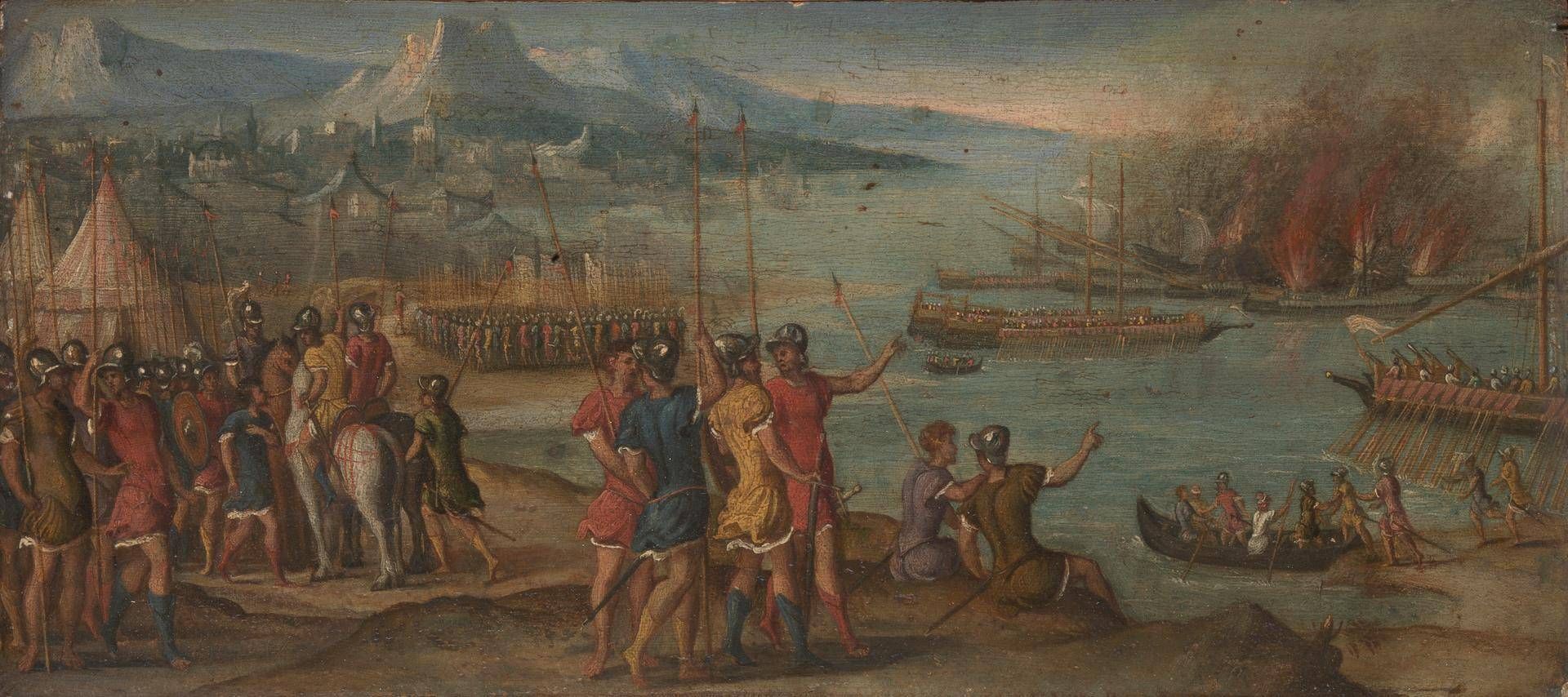
A Naval Battle
This is one of a series of five paintings that decorated furniture or wall panelling. The subjects of the series are all military and they may have been painted for the entrance hall of a Venetian palace, where arms and armour were often exhibited.
In the National Gallery's painting, foot soldiers are gathered before tents on the left. The three soldiers mounted on horses are possibly the commanders, as the foot soldier in blue appears to be reporting to the mounted soldier in yellow. Behind, in the middle distance, foot soldiers are massed in battle formation.
In the middle foreground, four soldiers stand in a group. The soldier in yellow carries a double-handed sword and is watching a naval battle in which several ships have burst into flame. Galleys are being rowed out towards the battle and soldiers on the right hurry into a rowing boat.
The standing soldier in yellow in the foreground appears to be the same character as the commander in yellow on the grey horse, repeated at a later point in the story as part of a continuous narrative. However, all of the distinct colours appear several times in the painting, and gestures are also repeated, so the repetition of the figure in yellow may just be accidental or to create a decorative colour rhythm across the picture.
The other paintings in the series are all in private collections. The subject of the second, which shows Romans gathered before a coastal military camp, has been identified as the Roman general Scipio Africanus receiving turbaned envoys. In the third panel, turbaned troops advance toward a stone city by the shore as a fleet of galleys approaches across the water. The fourth shows three Romans in urgent discussions while behind them troops are massed before a camp outside a walled city. The fifth scene is of foot soldiers in a battle on a damaged bridge outside a distant city.
All the panels feature soldiers in antique costume but wearing the standard burgonets (combat helmets) of the second half of the sixteenth century and carrying contemporary lances and swords. In two of the panels there are sixteenth-century galleons. In the second and third paintings, warriors are dressed in long robes and turbans like Ottoman Turks, the chief opponents of Venetian power at that time. It is not clear if the pictures are meant to represent sixteenth-century campaigns against the Turks in which the Venetians are given antique dress, or Roman campaigns against the Carthaginians in which the latter are given sixteenth-century Turkish dress. It may be that no specific historical battles were intended, but merely generic scenes of warfare.
Each panel is more or less the same size and is clearly painted by the same artist. The flowing lines of the figures and their fluttering draperies, small heads and large thighs are distinctive stylistic features also seen in The Labours of the Months, painted in Venice around 1580. We don't know who painted A Naval Battle, but can see the influence of a range of artists. The painting may date from after Bonifazio di Pitati's death when Schiavone introduced the elegance of Parmigianino's figures to Venetian painting. Similar soft bodies and repeated gestures can also be found in works by Paolo Fiammingo or by Pozzoserrato from around 1580.
Credit: Layard Bequest, 1916
c. 1580
Oil on wood
17.1 x 38.9 cm
NG3108
Image and text © The National Gallery, London, 2025
Where you'll find this

Permanent collection



